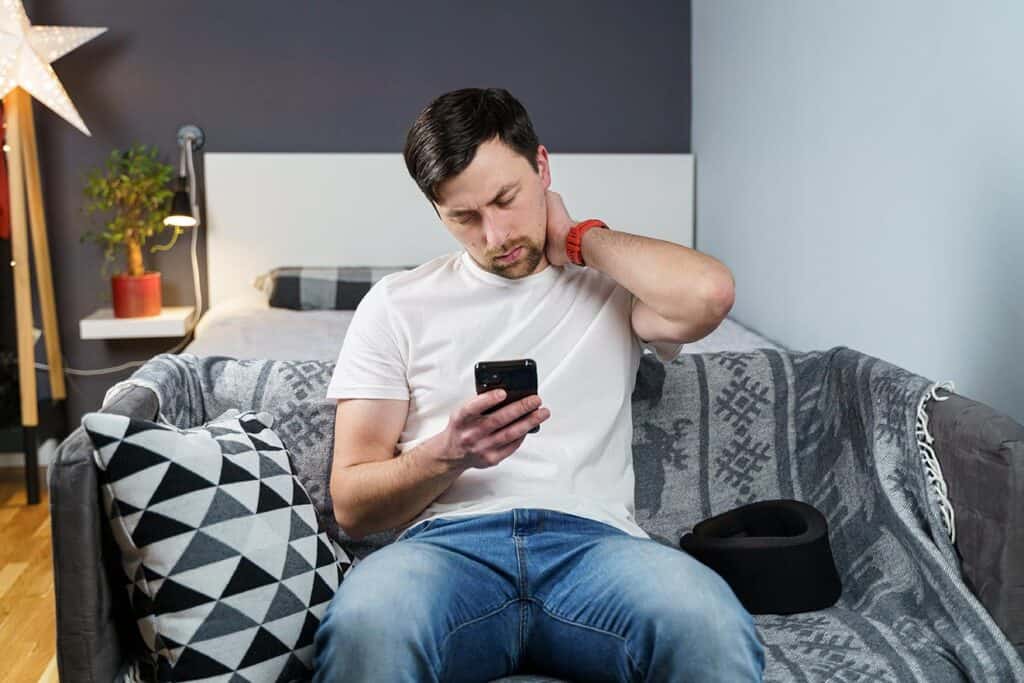How Your Phone Hurts Your Neck and What to Do About It
Could your cell phone be on the hook for that neck pain and muscle tightness you’re feeling in your cervical spine and shoulders? Chances are, it is. It’s estimated that 294.15 million Americans own a smartphone. When surveyed about their usage habits, respondents reported a whopping 5.5 hours per day of cell phone use! For many users, this could lead to neck and back pain from poor posture, slumping shoulders, and downward head positioning.
The role of your neck

Your neck supports the weight of your head, which is 10 to 12 pounds, or the weight range of a standard bowling ball. When your head is in its proper upright position, your neck feels no strain or stress from the weight of your head. As you use devices, your head moves forward, sometimes by 15, 30, 45, or 60 degrees to look down onto your device. When sustaining a 60-degree angle for long periods, the neck is holding upwards of 60 pounds of pressure—the weight of a 7-year-old boy. Imagine having that second grader sitting on your shoulders for the time you spend looking down at your phone.
The data also showed that 56% of Americas reported feeling addicted to their cell phones, which means this new wave of neck and shoulder pain associated with the device—commonly called text neck—and also known as –tech neck-, is here to stay. So, what are the symptoms and how do you prevent them from becoming a chronic pain problem?
Common symptoms of text neck
If you think the neck, upper back, and shoulder pain you’ve been feeling may be associated with text neck, here’s are a few tell-tale signs:
- Neck stiffness. Your neck is sore, difficult to turn, or is painful after using mobile devices over long periods.
- Tight shoulders. If your shoulders have aching pain and/or feel knotty between the blades near the base of the neck.
- Radiating pain. Pain traveling between the neck and shoulder blades to the shoulder blades and arms.
- Headache. You have tension headaches at the back of the head.
Tips for overcoming text neck
While the effects of text neck can be treated at home, recognizing when your body is taking on poor posture can help. Here are a few ways to prevent text neck or improve current neck, shoulder, and upper back pain.
- Give your device a reduced workload
Once upon a time, phones were only used to make and take calls. Smartphones have made it possible for you to do those along with sending text messages, playing games, posting social media updates, reading books and articles, listening to music, and more. It’s become the modern Swiss army knife.
By giving your phone limited functions, you can reduce your screen time and save your neck from pain. Perhaps you can choose to only use your phone for taking and making calls, texting friends, and updating social media. Other functions, like checking emails, and reading news, articles, and books, can be done on a desktop or laptop computer, or by thumbing through the pages of physical books, magazines, and newspapers. Gaming consoles can also replace cell phone games. This puts the action in your hands and your head upward facing a larger screen, which is beneficial to your neck and eyes.
Here’s a statistic you may not know. You may look at your phone more than you realize. The average number of pickups is 262 times per day —that’s once every 5.5 minutes! If you’re curious to know how much time you’re spending on your phone or device, iPhone users can enlist the built-in app Screen Time to monitor and set time limits on app use. Android users can download StayFree to achieve the same purpose. Better understanding your cell phone use habits can help you better understand your risk for text neck pain.
- Change your viewing position
Try placing your cell phone or tablet on a stand when using it to stream in your favorite shows or while scrolling through newsfeeds on social media. Cell phone stands and lazy phone holders are inexpensive and will put your screen at eye level. Some are even wearable and allow you to be hands free while keeping your phone at eye level.
Another way to use your cell phone or tablet in a way that is gentle on the neck and upper spine is to lie on your side. In a study in the International Journal of Human Factors and Ergonomics, researchers found that “lying on one’s back or lying on one’s side was more or less likely to lead to problems in the upper extremities of the musculoskeletal system.”
Ways to ease the pain
Whether you’re experiencing pain from ongoing or prolonged cell phone and tablet use, the two tips below will help you keep your posture spine in mind as you go about your day.
Check your posture every so often. Take a few moments to reset your neck and spine alignment. Your ears should be above your shoulders. Stand flush against a wall to realign your back into the correct posture.
Arch your back. Clasp your fingers together and extend your hands upward and then stretch backward. You can also move side to side to stretch more of your lower back. You can also do the same stretch using a forward motion to help with your shoulder blades.
Conclusion
Smartphones and tablets are an integral part of our daily lives, so learning to adapt our bodies to technology is important. These tips can help prevent the negative impact of smartphone and tablet use on your neck, spine, and shoulders. Once you begin to recognize the effects your devices have on your body and develop awareness, then these devices designed to make your life easier will be just that—and not a pain in your neck.



